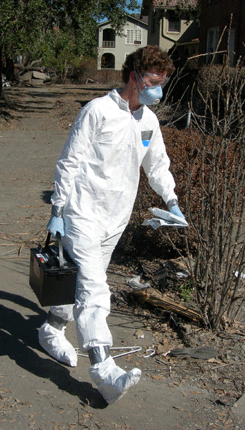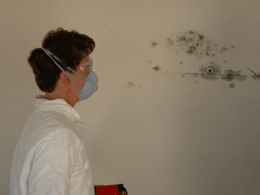New Orleans Mold
Air Date: Week of November 25, 2005
According to the Natural Resources Defense Council, mold spore levels in many parts of New Orleans are two to four times normal levels. Despite government safety warnings, residents are being allowed back into parts of the city with unsafe mold contamination counts. Many locals are complaining of runny noses, sore throats and a persistent cough. Host Steve Curwood talks with Dr. Gina Solomon, senior scientist for NRDC, which conducted independent mold measurements, and Dr. Dick Jackson, former head of the Center for Environmental Health at the Centers for Disease Control.
Transcript
CURWOOD: From the Jennifer and Ted Stanley Studios in Somerville, Massachusetts, this is Living on Earth. I'm Steve Curwood.
Many people returning to New Orleans have reported sore throats, runny noses, and a nagging hack that has been coined the "Katrina cough.” Some experts are linking the cough to extremely high levels of mold coming from the soggy wreckage left behind by the extensive flooding of the city. With city officials authorizing return to some areas the government is recommending that people use inexpensive face masks to keep from inhaling mold spores. But so far there have been no official counts of mold levels.
Joining me is Physician Gina Solomon, a senior scientist for the Natural Resources Defense Council, who conducted her own tests of mold in New Orleans in October. Also on the line is Dr. Richard Jackson, former head of the Center for Environmental Health at the Centers for Disease Control. Dr. Solomon, from what you saw on the ground in New Orleans, just how serious is the mold contamination?

Dr. Gina Solomon suited up in protective gear when she conducted mold testing in New Orleans. (Photo courtesy of NRDC)
CURWOOD: Dr. Jackson, what’s the problem with mold spores? What can they do to people?
JACKSON: These are complex microorganisms that your body develops immunity to, and that’s why you have allergies and begin sneezing and your eyes burn and the rest. Certain individuals can actually have direct toxic effects from the mold. And, in fact, if you have impaired immunity, the mold can begin to grow in your body and you have an inability to eradicate it. So simply because we can’t see it doesn’t mean we should ignore it and pay no attention. This can make people quite ill, it can set off asthma attacks. People can die from an asthma attack.
You really have to think about who are the people being exposed. One is a healthy person in a work setting – is going to need protective equipment. We are going to have to clean up those areas. Two is that folks that are at some immune or other kind of concern, one is going to have to think about how you also protect them. And actually have gradations of how they go into those areas.
CURWOOD: So the local authorities in New Orleans have said, Hey, it’s okay to go back into these areas. They are urging people to wear protective gear. Does this make sense from your perspective, Dr. Solomon?
SOLOMON: The zip codes that have been reopened for habitation, unfortunately, include some of the ones that had the highest mold levels in our study. That’s probably because a lot of that mold is being disturbed; a lot of people are ripping out drywall and sheet rock and the mold is flying around in the air. It, in my mind, would be wiser to wait until the dust settles, quite literally, and the mold spores settle, before having people back in that community.
CURWOOD: Dr. Jackson, what would be your advice as to the re-population of these areas?
JACKSON: I’m a little reluctant to say one size fits all. I can easily imagine a family that’s been living in a motel room, and the children have been going to a distant school that they don’t know. People are lonely for their family and their friends. There are real costs for those families as well. So folks are facing decisions that at some level are pretty personal, and I think the important thing is to get them the information they need. Here are what the exposures are; here are the ways you can protect yourself. But I’m reluctant to simply keep people out who have been displaced now for weeks and weeks and weeks because of measurements we’ve taken. That said, it is absolutely appropriate to be very concerned about these exposures.
CURWOOD: From your experience as a state and federal regulator, what responsibility do you think that the state or the federal government should have, in terms of measuring these mold levels in New Orleans?
JACKSON: The proper role of a place like CDC is to offer guidance and recommendations – here is how you can reduce levels, here is how you can protect yourself – and controls and protections both for workers and for the public.
CURWOOD: Why do you think the EPA or another government agency hasn’t stepped in to test for this mold? Why is a private organization like the Natural Resources Defense Council the source of information at this point?
JACKSON: I can’t speculate. I suspect that they’re feeling so overwhelmed with threats that are perfectly visible that these that are less visible, one is slower to begin to grasp and grapple with these.
CURWOOD: How does one dispose of moldy materials safely to not aggravate the health situation, Dr. Solomon?

Dr. Gina Solomon looks at mold on a house wall in New Orleans. (Photo courtesy of NRDC)
CURWOOD: If authorities were to come to you and say, Look, what do we do with all this moldy stuff? What would be the safe way to get rid of this so it doesn’t aggravate public health any further? Dr. Jackson, what would you tell them?
JACKSON: You know, I think after disasters one has this frantic desire to take care of what needs to be taken care of. I’ve seen over and over again that one of the major effects is really the emotional trauma the communities go through. And cleanup becomes almost its own – people become obsessed with the cleanup and oftentimes don’t regard or worry enough about their own protection. And I think the levels that have been laid out here really point out that, you know, this may seem small, it may seem invisible right now; over time we’ll realize, Oh my God, we should have made sure that everyone had the proper protections, the masks and the rest.
CURWOOD: I want to thank you both for taking this time. Dr. Richard Jackson is a professor at the School of Public Health at the University of California at Berkeley, and Dr. Gina Solomon is a senior scientist for the NRDC and clinical assistant professor at the University of California at San Francisco Medical School. Thank you both.
SOLOMON: Thank you.
JACKSON: Thank you, this is an important show.
Links
Living on Earth wants to hear from you!
Living on Earth
62 Calef Highway, Suite 212
Lee, NH 03861
Telephone: 617-287-4121
E-mail: comments@loe.org
Newsletter [Click here]
Donate to Living on Earth!
Living on Earth is an independent media program and relies entirely on contributions from listeners and institutions supporting public service. Please donate now to preserve an independent environmental voice.
NewsletterLiving on Earth offers a weekly delivery of the show's rundown to your mailbox. Sign up for our newsletter today!
 Sailors For The Sea: Be the change you want to sea.
Sailors For The Sea: Be the change you want to sea.
 The Grantham Foundation for the Protection of the Environment: Committed to protecting and improving the health of the global environment.
The Grantham Foundation for the Protection of the Environment: Committed to protecting and improving the health of the global environment.
 Contribute to Living on Earth and receive, as our gift to you, an archival print of one of Mark Seth Lender's extraordinary wildlife photographs. Follow the link to see Mark's current collection of photographs.
Contribute to Living on Earth and receive, as our gift to you, an archival print of one of Mark Seth Lender's extraordinary wildlife photographs. Follow the link to see Mark's current collection of photographs.
 Buy a signed copy of Mark Seth Lender's book Smeagull the Seagull & support Living on Earth
Buy a signed copy of Mark Seth Lender's book Smeagull the Seagull & support Living on Earth

